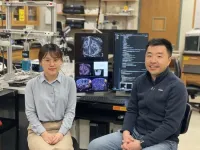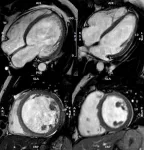(Press-News.org) A simple and convenient method to collect drug use data from the surface of a smartphone is revealed for the first time in a new study published in De Gruyter’s Clinical Chemistry and Laboratory Medicine. By helping clinicians understand what drugs people are taking in certain contexts, the research could protect public health and improve the treatment of patients suspected of overdosing.
Understanding the most common drugs in a particular area, who uses them, when they use them and in what contexts can help inform life-saving treatment decisions but given the illegal nature of many recreational drugs, such data are not always easy to obtain. Researchers can employ indirect techniques, such as analyzing wastewater or conduct anonymous surveys with drug users, pairing the results with toxicological measurements such as blood or urine samples. However, such approaches can be inaccurate and too invasive for routine use.
Dr. Théo Willeman of Grenoble Alpes University Hospital, France and colleagues explored whether one of our most handled objects – the smartphone – could be a more convenient way to track drug use. Fingerprints on a phone’s surface contain sweat and sebum that can reveal the presence of drugs, and the surface itself can retain traces of any drugs consumed directly from it.
The researchers invited drug users at techno and trance music events in France to anonymously complete a questionnaire about their drug use, and then dry swabbed the surface of their smartphones. The swabs were later analyzed using liquid chromatography to detect drugs.
The researchers collected and analyzed 122 swabs and successfully identified a variety of drugs. The three most common were MDMA, cocaine and THC, but the researchers also found ketamine, LSD, methamphetamine, CBD, heroin and mescaline. The results confirm that smartphones can successfully provide a convenient and non-invasive way to assess drug use.
The study has some limitations. For instance, the stability of drug molecules on a smartphone surface is not known, and this could influence the results if substances degrade quickly or slowly. The method is also limited by the possibility that several people may have handled the smartphone or it could be contaminated by drug traces in the environment. However, the study is intended as a proof-of-concept, and further research can cast light on these unknowns and further validate the technique.
“The opioid crisis in the US was recognized as a public health emergency by the US President in 2016,” said Dr. Willeman. “As a result, developing new tools to perform toxico-epidemiology studies is crucial, and identifying which substances are consumed in a particular area may help medical teams managing potential intoxications.”
END
Smartphone swabs provide convenient toxicology testing
Dry swabs can be successfully used to detect drugs on smartphone surfaces, study shows
2024-04-22
ELSE PRESS RELEASES FROM THIS DATE:
Advancing high-resolution ultrasound imaging with deep learning
2024-04-22
Researchers at the Beckman Institute for Advanced Science and Technology developed a new technique to make ultrasound localization microscopy, an emerging diagnostic tool used for high-resolution microvascular imaging, more practical for clinical settings. Their method uses deep learning to advance in the post-processing pipeline of ULM.
Their technique, called LOcalization with Context Awareness Ultrasound Localization microscopy, or LOCA-ULM, appears in the journal Nature Communications.
“I’m really excited about making ULM faster and better so that more people will be able to use this technology. I think deep learning-based computational ...
New study confirms community pharmacies can help people quit smoking
2024-04-22
A new study shows community pharmacies may play a key role in helping people quit smoking.
The findings came out in the article Closing the Tobacco Treatment Gap, published in the 10th anniversary special issue of Pharmacy. The results provide valuable insights into the implementation of tobacco cessation services within community pharmacies while identifying barriers to further improvements.
Tobacco use remains a leading preventable cause of death. Although two thirds of people who smoke would like to quit, many individuals trying to quit on their own are not successful. To address this gap, the study explored how ...
Book aims to re-design the up-skilling game. Rotman School author says we need a re-set in the way we think about human skill in the genAI era
2024-04-22
April 22, 2024
Book Aims to Re-Design the Up-Skilling Game. Rotman School Author Says We Need a Re-Set in the Way We Think About Human Skill in the GenAI era
Toronto – Although communicative and relational skills are currently in the greatest demand in organizations large and small, we are as educators, executives, and talent developers very far away from the kind of precision in identifying, measuring, selecting, and developing these skills that we have achieved with cognitive and technical skills. At the same time, the automation ...
Could automation, electrification of long-haul trucking reduce environmental impacts?
2024-04-22
April 22, 2024
Contact: Lori Atherton, SEAS, lorather@umich.edu
Jim Erickson, Michigan News, ericksn@umich.edu
A new University of Michigan study finds that automation and electrification of long-haul trucking can reduce urban health impacts and environmental damages.
For long-haul routes below 300 miles, electrification can reduce air pollution and greenhouse gas damages by 13%, or $587 million annually, according to the study. ...
European union should adopt a research-based approach to ensure the quality and safety of substances of human origin
2024-04-22
April 22, 2024
European Union Should Adopt a Research-Based Approach to Ensure the Quality and Safety of Substances of Human Origin
London/Toronto – Substances of human origin (SoHOs) such as blood, plasma, skin, corneas, and embryos play an increasing role in life-saving medical procedures. Governments around the world are reevaluating their healthcare policies to ensure of a supply of SoHOs for their population, while also considering the best-interests of both donors and patients.
A ...
Study identifies signs of repeated blast-related brain injury in active-duty United States Special Operations Forces
2024-04-22
Repeated exposure to explosive blasts has the potential to cause brain injuries, but there is currently no diagnostic test for these injuries
In a study of 30 active-duty United States SOF personnel, researchers found that increased blast exposure was associated with structural, functional, and neuroimmune changes to the brain and a decline in health-related quality of life
The researchers are now designing a larger study to develop a diagnostic test for repeated blast brain injury
United States (US) Special Operations Forces (SOF) personnel are frequently exposed to explosive blasts during training and combat. However, ...
Mount Sinai scientists discover the cellular functions of a family of proteins integral to inflammatory diseases
2024-04-22
New York, NY (April 22, 2024) – In a scientific breakthrough, Mount Sinai researchers have revealed the biological mechanisms by which a family of proteins known as histone deacetylases (HDACs) activate immune system cells linked to inflammatory bowel disease (IBD) and other inflammatory diseases.
This discovery, reported in Proceedings of the National Academy of Sciences (PNAS), could potentially lead to the development of selective HDAC inhibitors designed to treat types of IBD such as ulcerative colitis and Crohn’s disease.
“Our understanding of the specific function of class II HDACs in different cell types has been limited, impeding ...
Spanish scientists identify the key cell type for strategies to prevent atherosclerosis in progeria syndrome
2024-04-22
Hutchinson-Gilford progeria syndrome (HGPS) is an extremely rare genetic disease that affects just 1 in every 20 million people; it is estimated that fewer than 400 children in the world have the disease. HGPS is characterized by accelerated aging, severe atherosclerosis, and premature death at an average age of about 15 years. Although people with HGPS do not normally have conventional cardiovascular risk factors (hypercholesterolemia, obesity, smoking, etc.), most patients die from the complications of atherosclerosis: myocardial ...
A new Spanish study provides the first stratification of the risk of developing dilated cardiomyopathy among symptom-free genetic carriers
2024-04-22
Dilated cardiomyopathy is the most frequent cause of heart failure in young people and is the leading cause of heart transplantation. In this disease, the heart enlarges and reduces its capacity to pump blood. People with dilated cardiomyopathy are at high risk for arrhythmias and sudden death.
In approximately 30%–40% of people with dilated cardiomyopathy, the disease is caused by a genetic mutation. When a genetic cause is identified, the patient’s family members can be studied to determine if they have also inherited the altered gene.
Family members who are carriers of the genetic mutation are at risk for developing the disease in ...
International Lawyer from the University of Warwick calls for fairness in WHO Pandemic Treaty Talks
2024-04-22
As the World Health Organization (WHO) pushes for countries to seal the Pandemic Treaty by May this year, researchers at the University of Warwick and Kings College London stress the need for fair negotiations.
The opinion piece, featured in PLOS Global Public Health journal, is led by Professor Sharifah Sekalala . The team highlights the importance of considering "Time Equity" in these talks, urging caution on setting deadlines and sharing the burden when time is tight.
Since COVID-19 hit, demands for health equity ...
LAST 30 PRESS RELEASES:
Electrodes created using light
Second-hand gift-giving is a well-deliberated decision
How human interaction drove evolution to make bears less aggressive
National Poll: Few parents offer teens guidance on healthy eating during holiday season
Cannabis derivatives could provide new ovarian cancer treatments
Raising strong yeast as a petroleum substitute
Clues to the origin of hot Jupiters hidden in their orbits
Canada’s reduced pledge to Global Fund will impact domestic health
1 in 4 children with major traumatic injuries not cared for in pediatric trauma centres
Duke and Duke-NUS’ joint cross-population research to uncover "East-West" differences in disease and care
Scientists to ‘spy’ on cancer- immune cell interactions using quantum technology breakthrough
Tech savvy users have most digital concerns
Making lighter work of calculating fluid and heat flow
Normalizing blood sugar can halve heart attack risk
Lowering blood sugar cuts heart attack risk in people with prediabetes
Study links genetic variants to risk of blinding eye disease in premature infants
Non-opioid ‘pain sponge’ therapy halts cartilage degeneration and relieves chronic pain
AI can pick up cultural values by mimicking how kids learn
China’s ecological redlines offer fast track to 30 x 30 global conservation goal
Invisible indoor threats: emerging household contaminants and their growing risks to human health
Adding antibody treatment to chemo boosts outcomes for children with rare cancer
Germline pathogenic variants among women without a history of breast cancer
Tanning beds triple melanoma risk, potentially causing broad DNA damage
Unique bond identified as key to viral infection speed
Indoor tanning makes youthful skin much older on a genetic level
Mouse model sheds new light on the causes and potential solutions to human GI problems linked to muscular dystrophy
The Journal of Nuclear Medicine ahead-of-print tip sheet: December 12, 2025
Smarter tools for peering into the microscopic world
Applications open for funding to conduct research in the Kinsey Institute archives
Global measure underestimates the severity of food insecurity
[Press-News.org] Smartphone swabs provide convenient toxicology testingDry swabs can be successfully used to detect drugs on smartphone surfaces, study shows




